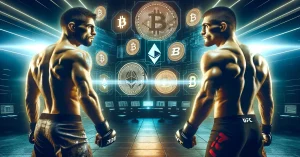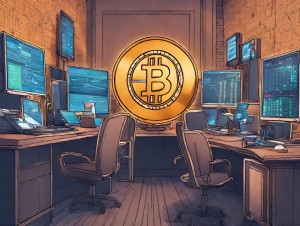The Terra Luna crash which happened last May caused many to lose their life savings and lose their faith in so-called stablecoins. Was this due to what started as a “speculative bet”? Do Kwon readily submits, “I alone am responsible.” What happened to Terra Luna, or more precisely, what caused the domino effect that led to nearly $45 billion (€44 billion) loss within 72 hours in May?
Quo Vadis is a Latin phrase meaning “Where are you marching?” It is also commonly translated as “Where are you going?” This is the question that confronts one who has fallen from such great height that it’s almost impossible to come back. For LUNC to reach the $1 mark, it would need to surge by a staggering 8000 times. This would result in a market capitalization of $5900 billion for Luna Classic, over twice the market cap of tech giant Apple. If LUNC were to grow at a steady rate of 25% per annum, it would take an estimated 39 years for it to reach $1.
So, why are we looking into where Terra Luna Classic (LUNC) is going? With the current supply, it’s virtually impossible for that to happen, and it will take a very long time before the LUNC burn tax has a noticeable effect on the supply of LUNC. But be heartened, fueled by a passionate community and deep developer talent pool, the Terra blockchain is built to enable the next generation of Web3 products and services. So, let’s retrace the steps that led to its downfall and find a safer way back.
The beginning of the awful crash
In April 2018, a few months after plans to create Terra surfaced, Cyrus Younessi, head of the risk at MakerDAO and a former research analyst at Scaler, told Scaler why he believed Terra/LUNA would not work, describing a scenario that later unfolded on 5 May 2022. On a fateful day (May 13), Luna prices plummeted from $87 to $0.0005.
Terra’s widely adopted stablecoin, UST, fell from its 1:1 USD peg to 0.03:1 USD for the lowest price. The collapse shook the entire crypto industry, accelerating the 2022 bear run by triggering the firesale of BTC and other stablecoins and bringing about systematic havoc that’s still happening today.
Over *four years* ago I was a research analyst at @scalarcapital.
— cyy.eth 🦇🔊 (@cyounessi1) May 13, 2022
The Terra / $LUNA deal came across our desk and I was assigned to it because I was the DeFi guy. Here's what I had to say about the project.
How did we allow it to end up like this? pic.twitter.com/LZMU1H7BdG
The Terra Luna crash makes a fine example of Murphy’s law – anything that can go wrong will go wrong. The order of events following the crash has been defined as a death spiral that resulted in the death of the entire Terra Luna ecosystem.
So, how did Terra Luna fall from a market leader to one of the most significant failures in the crypto industry? And who is Do Kwon, the man behind Terra Luna, and is he going to jail? Will UST recover, and what’s Luna 2.0? To answer these questions, we will dive into how the Terra Ecosystem worked and how Do Kwon overlooked a simple mishap that resulted in his downfall.
How Terra protocol works
For the uninitiated, Terra is a blockchain that enables the creation of stablecoins. A stablecoin is a cryptocurrency whose value is pegged to that of a fiat currency or tradeable item like Gold on a 1:1 ratio. In our case, UST was pegged to the US Dollar in that one UST could be exchanged for 1 USD at any time. Usually, the value of stablecoins is backed by their corresponding pegs, but the Terra UST was fundamentally different. UST had no formal backings; instead, the Terra protocol algorithmically pegged it to USD, the protocol used the Luna token to absorb volatility from the system, and the theory worked great.
To maintain TerraUSD (UST), a USD value of Luna is convertible into a 1:1 ratio with UST tokens. If UST’s price drops to US$0.98, arbitrageurs swap 1 UST for $1 of USD and make a profit of US$0.02. The mechanism increases UST demand and reduces its supply.
When UST rises above US$1, say at US$1.02, arbitrageurs convert US$1 worth of Luna into 1 UST and make US$0.02. The supply of UST increases, and demand for UST also decreases, bringing the price back to the peg.
Hence, Luna serves as a shock absorber for UST’s price volatility. For this stabilizing price mechanism to work, Luna holders can redeem 1 UST for US$1 worth of Luna, even if UST is worth less than US$1.
Do Kwon and the Terra Ecosystem
Do Kwon, the founder, and CEO of the Terra network, launched the network it in January 2018 with plans to develop Chai, an e-commerce payments application, and create a price-stable cryptocurrency against significant fiat currencies to facilitate transactions. Terraform labs’ was later created in April to develop Terra blockchain, and in January 2019, Luna sold at $0.18 seed round and $0.80 at the private sale.
In September 2021, the U.S. Securities and Exchange Commission (SEC ) subpoenaed Terraform Labs founder Do Kwon with concerns that Mirror may violate federal securities law. In response to a vulnerability on Terra, Do Kwon ruled out the possibility of a George Soros-style attack on UST/LUNA that could send it into a death spiral. Some analysts would later, in mid-2022, claim this is the type of scenario that spurred Terra’s demise.
Probably the most retarded thread ive read this decade.
— Do Kwon 🌕 (@stablekwon) November 28, 2021
Silence is a perfectly acceptable option if stupid.
Billionaires in my following, go ahead, see what happens https://t.co/wtt9OhX4kg
At the end of 2021, the value of Luna tokens nearly doubled, recording highs of above $90, and was up 58% in December.
In January 2022, Do Kwon announced the launch of the Luna Foundation Guard (LFG), an organization whose mandate was to build reserves supporting the $UST peg amid volatile market conditions and to allocate resources supporting the growth and development of the Terra ecosystem through grants.
1/ The first step towards {REDACTED} is now complete.
— Terra 🌍 Powered by LUNA 🌕 (@terra_money) January 20, 2022
Introducing the formation of the Luna Foundation Guard (LFG).https://t.co/oqke82OUB2 pic.twitter.com/QKGwrhmtMH
The Luna Foundation Guard (LFG) would later raise $1 billion through the sale of LUNA tokens to buy Bitcoin for the UST stablecoin reserve system, with Three Arrows Capital and Jump Crypto being the lead crypto investors. The fund would continue growing in the months leading to the crash.
On 13 March 2022, Crypto trader Algod likened UST/LUNA to a Ponzi scheme and made a $1M bet against Do Kwon that the price of LUNA would be below $88 by March 2023. Another crypto trader, GiganticRebirth, bet $10 million against Kwon that LUNA would fall below $88 in 2023. Do Kwon took the bet.
Interested in same bet for 10 million dollars [considered offering 50 million, but escrow becomes tricky]
— GCR (@GiganticRebirth) March 14, 2022
Would donate half to charity
Expect price to pump short term, but in 1 year, supremely confident the current narrative is lost@stablekwon https://t.co/2SJAvZh4Yp
Do Kwon took the bet … and lost.
It’s a different coin, bet was lost the moment he forked and airdropped.
— Algod(τ, τ) (@AlgodTrading) May 31, 2022
Do Kwon later tweeted that the DAI stablecoin would die by his hand and began earnest plans to starve off the decentralized stablecoin DAI’s liquidity on Curve Finance. Analysts have used the tweet to describe Do Kwon’s personality at the height of the Luna cryptocurrency dominance in the crypto market.
On 5 April 2022, the LUNA token reached an all-time high of $119.2, according to Coinmarketcap. The circulating supply of LUNA dropped to an all-time low of 346 million tokens as LUNA tokens were burned to keep up with the rising demand for UST.
During the crash months later, Do Kwon would joke his way out of UST’s depegging risk.
The downfall of Terra Network – May 2022
On 8 May 2022, @Curveswaps, a Twitter bot showing blockchain swaps above $200k, flagged an $85 million UST swap for $84.5 million USDC
🚀Swap 85,001,010 $UST to 84,509,387 $USDC ($84,969,985)
— Curve Whale Watching (@CurveSwaps) May 7, 2022
LP & veCRV Holder Fee: $33,988
💰Tx Hash: https://t.co/rbLEl4IndA 🦙🦙🦙
UST depegged to $0.985 on the same day following a series of large dumps of UST on Terra’s lending protocol and stablecoin exchange protocol Curve. The LFG committed a $750 million BTC loan to market makers to defend the peg of UST and another $750 million of UST to buy back BTC after volatility subsides. Deposits on the Anchor protocol plunged below $9 billion from $14 billion after UST struggled to recover to $1.
On May 9, UST lost its $1 peg for the second time and fell to as low as 35 cents, and claims that UST’s Depeg is due to a Soros-esque attack began to emerge.
On May 12, the LUNA price fell 96%, pushing it below $0.10 in a day, after which the Terra blockchain was officially halted at block height 7603700 and later at block 7607789 but resumed activity after about nine hours. Today, the price of Terra Luna sits at $0.40 on CoinMarketCap. After several proposed recovery projects, none seem to work this far.
In response, Okx and Binance crypto exchanges halted the trading of Terra tokens, and LUNA slumped by more than 99%.
The Luna Foundation Guard later confirmed it depleted its BTC reserves from around 80,000 bitcoins to 313 bitcoins while attempting to save UST’s peg.
On May 16, Do Kwon proposed a Terra fork without UST, calling the original Luna, Luna Classic amid agitated investors who reportedly lost over $28B.
A breakdown of the attack
Here is a breakdown of the attack, as outlined by Huobi Research Institute.
1. Alleged attackers find vulnerabilities in the Terra protocol
As Terraform Labs prepared for the 4pool launch, the attacker deposited more UST liquidity into the curve. According to Forbes, the attacker swapped $350 million of UST for USDC on the Curve protocol causing a significant imbalance between the UST (85%) and 3CRV (15%) in the pool.
Subsequently, a bank run on Anchor resulted in users rushing to pull out their funds and swap out of UST, as stated in the same Forbes article.
2. An arbitrage trade
As the defense liquidity pool played out, the attacker kept threatening the sale of UST as an arbitrage trade (buying and selling assets in different markets.) Since the defenses were down in guarding the peg, the attacker launched a full-scale swap on the curve resulting in an imbalance of UST in the pool despite the algorithm’s attempt to restore the peg.
The imbalance intensified the supply of Luna in the market.
3. The big short
The alleged attacker is aware that the peg cannot be quickly guarded with an external liquidity pool and opens up the execution phase for the attack plan.
After the pool UST crashed, depositors quickly withdrew UST and swapped it for Luna. The swap put pressure on Luna, reducing Terra’s liquidity as the primary source to buy back UST.
In response, the now panicking LFG sold assets like BTC and depleted all its reserve assets to boost the value of UST. The efforts would prove futile, resulting in the whole Terra chain suffering from a liquidity crisis where the entire value of Luna could not balance out the value of UST.
4. Luna’s supply inflates
In efforts to restore the peg, the algorithm minted more Luna for each UST burnt, creating a hyperinflationary loop in Luna’s supply. Luna’s value fell as arbitrageurs scooped up UST, burnt it, and minted Luna, then dumped that Luna on the market.
The mechanism’s goal is that UST could re-peg if it worked, but the risk here is that Luna could go to zero. In that case, UST plummets to zero too. Eventually, Murphy’s law played out; both UST and Luna lost virtually all their value in a matter of days.
Terra Luna Recovery Plan
On May 25, Terra blockchain validators voted to approve Do Kwon’s plan to launch a new blockchain tagged “Terra 2.0” without a stablecoin. Previous LUNA and UST holders would receive an airdrop of luna (LUNA) based on their holdings. The old Terra blockchain remained functional, and validators renamed its token Luna classic (LUNC).
After freezing his passport, the South Korean Republic pleaded to Interpol to issue a red notice against the co-founder of Terra ecosystem, Do Kwon. The move is per a larger plan to ensure that the Terra boss is apprehended to answer for the Terra mishap. In the report shared by several sources, South Korea plans to finalize a procedure to see Do Kwon on the red list.
The Interpol red list is a notice to other nations in which a person is arrested based on pending extradition, surrender, or similar legal action. So Do Kwon’s days are numbered; soon, he will be arrested.
In defense, Do Kwon took to Twitter to say he was not on the run. He noted that should any government want a dialogue, he and his team are ready to discuss it, as their activities have been straightforward over the years.
Meanwhile, Binance, the largest crypto exchange in the world, added an opt-in button for a 1.2% tax burn on all LUNC trades following a similar move by the Terra classic DAO to burn Luna tokens and restore sanity.
What does the future of Terra Luna look like?
The Terra Luna Classic community re-voted on a critical proposal to support the USTC Quant team near the end of August 2023, after an early plan failed to achieve the required number of votes to pass the benchmark.
Additionally, the Terra Luna Classic community officially passed the major proposal on September 4th, 2023, to create dynamic minimum commissions for validators dependent on voting power. Validators on the LUNC network supported and agreed with the proposal to improve decentralization and protect the Terra Luna Classic network from potential vulnerabilities.
At the moment, the Terra Luna Classic is voting on a proposal by a developer to test market swap with a limiter by the core development team of the L1 Terra Classic Task Force (L1TF). The market swap mechanism for LUNC and USTC was blocked following the 2022 Terra-LUNA crisis. However, it can help repeg USTC and restore the LUNC price to $1. The Quant USTC repeg team rejected the limiter option on L1TF.
Also read:





